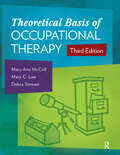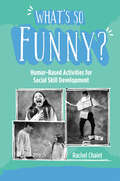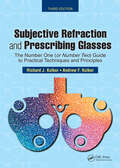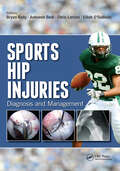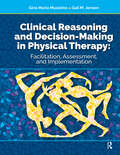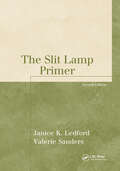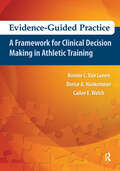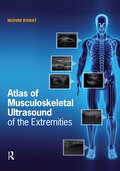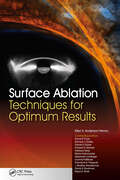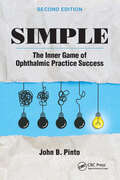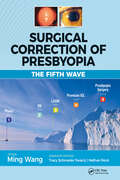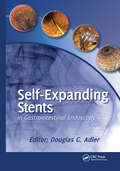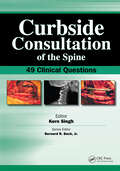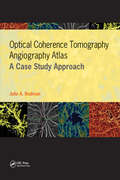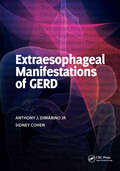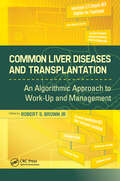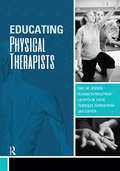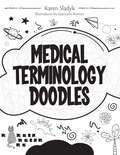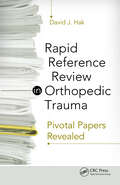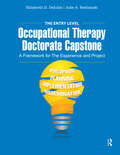- Table View
- List View
Theoretical Basis of Occupational Therapy
by Mary Ann McColl Mary C. Law Stewart DebraTheoretical Basis of Occupational Therapy, Third Edition shows the results of an exhaustive review of international peer-reviewed literature in occupational therapy and provides a synthesis of current theoretical developments in occupational therapy and occupational science. This helps occupational therapy students, researchers, and clinicians understand how to think about occupation, the many factors that affect occupation, and how to use occupation therapeutically to promote health and well-being. Unlike earlier editions, this updated Third Edition debuts during a time when even casual searchers can readily find huge amounts of information on the internet with the click of a search button. To remain relevant, this Third Edition goes beyond simply providing an annotated bibliography of peer-reviewed literature by also giving readers an analysis and synthesis of these documents in a clear and compelling organizational structure. Led by Mary Ann McColl, Mary Law, and Debra Stewart, Theoretical Basis of Occupational Therapy, Third Edition also offers an appendix that catalogs the literature included. In each of the determinants of occupation chapters, the contributors have extracted key themes, followed threads of theoretical development, reflected on external influences of occupational therapy theory, and commented particularly on developments over the last 15 years. New Features of the Third Edition: An updated database of articles A look at both determinants and consequences of occupation Further development of the three metaphors (the filing cabinet, toolbox, and telescope) that help organize and retrieve occupational therapy theory New contributing authors to supplement content New sections about the major named occupational therapy models Theoretical Basis of Occupational Therapy, Third Edition offers a classification system for theory, a digest of new developments in each area of the classification system, and a commentary on theoretical developments across theory areas that advance the knowledge and expertise of the profession as a whole.
What's So Funny?: Humor-Based Activities for Social Skill Development
by Rachel ChaietWith ready-to-use lessons and strategies, What’s So Funny?: Humor-Based Activities for Social Skill Development provides readers with tools to help their clients improve their emotional intelligence through humor. Occupational therapists, speech-language pathologists, special educators, behavior therapists, and caregivers will benefit from the implementation of these strategies.What’s So Funny? contains a curriculum of more than 50 activities that emphasize two main ideas. The first is that humor (linguistic or physical) can be taught to many individuals with autism spectrum disorder or other disorders through explicit instruction, exposure to various types of humor, and embracing the individual’s preferred sense of humor. The second is that humorous activities can be used to increase social engagement, which can sometimes be a challenge for those with developmental disabilities.What’s So Funny? includes activities essential for individuals who: Appear to have a very limited concept or basic developmental level of humor Need to improve their understanding of socially appropriate humor Lack understanding of appropriate times to use humor Are nonverbal, have limited expressive communication skills, or use augmentative communication devices Have a difficult time initiating social interactions with their peers With a flexible program that can be used for either small groups or individuals from ages 7 years to adult, What’s So Funny?: Humor-Based Activities for Social Skill Development is a relevant and easy-to-use resource. Discussing a variety of types of humor on different developmental levels, from slapstick to word play, this program improves participants’ abilities to connect and engage with others through the powerful tool of humor.
Subjective Refraction and Prescribing Glasses: The Number One (or Number Two) Guide to Practical Techniques and Principles, Third Edition
by Richard KolkerBasic refraction is a foundational part of ophthalmology, and yet beginning ophthalmology residents and ophthalmic technicians are often left on their own to learn the finer points. Despite being core skills, the techniques and practical aspects of subjective refraction and prescribing glasses are often developed by trial and error, if they are developed at all.Subjective Refraction and Prescribing Glasses: The Number One (or Number Two) Guide to Practical Techniques and Principles, Third Edition is designed as a complete guide to those essential skills, offering everything from basic terminology to tips, tricks, and best practices. This updated Third Edition has been expanded in every section with thoughtful, practical advice, and has case scenarios, in a question and answer format, of situations encountered with real-world patients. It is the most comprehensive review of clinical subjective refraction to date. Drs. Richard Kolker and Andrew Kolker together have nearly 50 years of experience in the practice of ophthalmology and bring both the fresh eyes of a beginning ophthalmologist and the experience of a seasoned veteran to this Third Edition. While new residents and technicians will appreciate the thorough explanation of refractive fundamentals, even expert ophthalmologists will appreciate the practical tips that may have never occurred to them. Included are: Very clear, easy-to-read, practical explanations of the subjective refraction process Basic practical optics to explain the steps of subjective refraction The Jackson Cross Cylinder made easy to understand and use Plus and mInus cylinder methods discussed separately and color coded for quick identification An Appendix with a primer on retinoscopy and how to use the manual lensometer The art of subjective refraction and prescribing glasses Subjective Refraction and Prescribing Glasses: The Number One (or Number Two) Guide to Practical Techniques and Principles, Third Edition is the definitive guide to the often neglected skills involved in clinical subjective refraction. Residents and technicians will find it a critical guide in their learning process, but even seasoned ophthalmologists can benefit from the tips and tricks enclosed within.
Sports Hip Injuries: Diagnosis and Management
by Bryan Kelly Asheesh Bedi Chris Larson Eilish O'SullivanIn the world of sports, hip injuries among an athletic population can be very difficult to diagnose and manage. That’s why Sports Hip Injuries: Diagnosis and Management is a comprehensive guide to diagnosing and managing sports hip injuries and hip preservation. Drs. Bryan Kelly, Asheesh Bedi, Chris Larson, and Eilish O’Sullivan are leaders in the field of hip preservation. They present Sports Hip Injuries: Diagnosis and Management in a concise manner by focusing on hip and pelvis disorders and cover all of the typical disorders seen in athletes presenting with hip and pelvic pain. The anatomy, presentation, clinical evaluation, imaging, nonsurgical and surgical treatment, and post-surgical rehabilitation of hip joint disorders are presented clearly throughout.Some of the topics Include: Femoroacetabular impingement Hip instability/dysplasia Athletic pubalgia/core muscle injury Stress fractures and traumatic sports injuries of the hip and pelvis Myotendinous injuries and nerve entrapment disorders of the hip and pelvis Rehabilitation guidelines and return to sport outcomes Sports Hip Injuries: Diagnosis and Management is an invaluable resource for sports medicine providers including orthopedic surgeons and fellows that care for patients presenting with hip pain for athletes at all levels, as well as physical therapists and athletic trainers.
Clinical Reasoning and Decision Making in Physical Therapy: Facilitation, Assessment, and Implementation
by Gail Jensen Gina MusolinoClinical reasoning is an essential non-negotiable element for all health professionals. The ability of the health professional to demonstrate professional competence, compassion, and accountability depend on a foundation of sound clinical reasoning. The clinical reasoning process needs to bring together knowledge, experience, and understanding of people, the environment, and organizations along with a strong moral compass in making sound decisions and taking necessary actions. While clinical reasoning and the role of mentors has been a focus of the continued growth and development of residency programs in physical therapy, there is a critical need to have a broader, in-depth look at how educators across academic and clinical settings intentionally facilitate the development of clinical reasoning skills across one’s career. Clinical Reasoning and Decision Making in Physical Therapy: Facilitation, Assessment, and Implementation fills this need by providing a comprehensive and in-depth focus on development of the patient-client management skills of clinical reasoning and clinical decision-making. It takes into account teaching and learning strategies, assessment, and technological applications across the continuum from novice to residents/fellows-in-training, along with academic and clinical faculty for both entry-level and specialist practice. Drs. Gina Maria Musolino and Gail Jensen have designed this comprehensive resource with contributions from professional colleagues. The text centers on life-long learning by encouraging the development of clinical reasoning abilities from professional education through residency education. The aim and scope of the text is directed for physical therapy education, to enhance clinical reasoning and clinical decision-making for developing professionals and post-professionals in both clinical and academic realms, and for the development of clinical and academic faculty.Clinical Reasoning and Decision Making in Physical Therapy uniquely offers both evidence-based approaches and pragmatic consultation from award-winning authors with direct practice experiences developing and implementing clinical reasoning/clinical decision-making in practice applications for teaching students, residents, patients, and clinical/academic faculty in classrooms, clinics, and through simulation and telehealth.Clinical Reasoning and Decision Making in Physical Therapy is the first of its kind to address this foundational element for practice that is key for real-world practice and continuing competence as a health care professional. Physical therapy and physical therapist assistant students, faculty, and clinicians will find this to be an invaluable resource to enhance their clinical reasoning and decision making abilities.
Prevention Practice and Health Promotion: A Health Care Professional’s Guide to Health, Fitness, and Wellness
by Catherine Rush ThompsonThe all-encompassing Second Edition of Prevention Practice and Health Promotion: A Health Care Professional’s Guide to Health, Fitness, and Wellness offers foundational knowledge to health care professionals implementing primary, secondary, and tertiary prevention to healthy, at-risk, and disabled populations.Dr. Catherine Thompson along with her contributors, all with diverse backgrounds in physical therapy, rehabilitation, and healthcare, present the interdisciplinary health care perspective of health, fitness, and wellness concepts that are critical for providing preventive care to healthy, impaired, and at-risk populations using the World Health Organization’s International Classification of Functioning, Disability, and Health model as a guideline for assessment and management.Based upon the goals outlined in Healthy People 2020, Prevention Practice and Health Promotion, Second Edition also combines the vision of direct access for health care professionals with the goals of national health care to increase the quality of years of healthy life, as well as to eliminate health disparities between various populations. Recognizing the cost effectiveness of preventive care, health care professionals have an expanded role in health promotion and wellness, complementing evidence-based medical management of acute and chronic conditions.Some topics covered inside Prevention Practice and Health Promotion, Second Edition include an overview of screening across the lifespan; effective interventions to promote health, fitness, and wellness; and options for program development, including marketing and management strategies to address both individual and community needs.Included with the text are online supplemental materials for faculty use in the classroom.Features of the Second Edition:• Use of the American Physical Therapy Association’s Guide to Physical Therapist Practice, Second Edition for health promotion• Screening tools for special populations, including children, pregnant women, older adults, individuals with developmental disabilities, and people with chronic conditions affecting their quality of life• Resources to promote healthy living, including nutrition, stress management, fitness training, and injury preventionPerfect for clinicians, students, allied health professionals, rehabilitation specialists, physical medicine specialists, and recreation therapists, the Second Editionto Prevention Practice and Health Promotion is a valuable resource for everyone in the areas of health, fitness, and wellness.
The Slit Lamp Primer (The Basic Bookshelf for Eyecare Professionals)
by Janice K. LedfordThe Slit Lamp Primer is the complete book on the slit lamp for the ophthalmic and optometric office. Now updated into a second edition, this user-friendly introduction to the slit lamp microscope highlights the instrument's basic parts as well as examination and illumination techniques. Janice Ledford and Valerie Sanders explain more than just the fundamentals of the slit lamp. Written in a conversational style with supplemental photographs and diagrams, The Slit Lamp Primer delves into issues concerning the normal, postoperative, and problematic eye. Features of the patient history, including medications, are examined in light of the possible slit lamp findings. Detailed notes for proper documentation are included, along with tables to give guidelines for subjective grading of the findings. Updated and key features: The examination of patients on various systemic medications with a list of drugs that may have side effects visible with the slit lamp The examination of post-operative patients, with a new section that focuses on patients who have undergone refractive surgery Up-to-date study icons, key points listed at the beginning of each chapter, and "What the Patient Needs to Know" sidebars Photographs and descriptions of parts and care of the slit lamp Atlas of photographs of the normal eye Photographs of pathology Tables to assist in contact lens evaluation The Slit Lamp Primer, Second Edition is a valuable addition to the reference library of any ophthalmic and optometric paraprofessional or student. Explore the workings of a useful and effective instrument with the most practical and user-friendly book on the subject available today.
Evidence-Guided Practice: A Framework for Clinical Decision Making in Athletic Training
by Bonnie Van Lunen Dorice Hankemeier Cailee WelchAthletic trainers must have a foundation in the concepts of evidence-based practice to deliver patient care in an effective way. It is critical that students and clinicians formulate clinical plans that will be effective for individual patients. With that goal in mind, Evidence-Guided Practice: A Framework for Clinical Decision Making in Athletic Training teaches the athletic trainer that evidence-based practice concepts must be incorporated into daily clinical practice. Written in a conversational tone, Drs. Bonnie Van Lunen, Dorice Hankemeier, and Cailee Welch provide a practical and concise resource for athletic trainers to use when interpreting what the available evidence means for them and how it can be effectively applied in daily patient care. The competencies within athletic training and other health care professions were considered when each chapter was constructed. Special care was taken to include examples that are specific to athletic training and instructional applications for educators.What Is Inside: Types of research design Foundations of research and statistics Introduction to critical appraisal Concepts of validity Diagnostic accuracy Disablement models Patient-oriented outcome assessments Health care informatics The first of its kind, Evidence-Guided Practice: A Framework for Clinical Decision Making in Athletic Training is the only resource athletic training students, clinicians, or other health care professionals will need to properly put evidence-based concepts into practice.
Atlas of Musculoskeletal Ultrasound of the Extremities
by Mohini RawatFeaturing nearly 700 illustrations, images, and photos, Atlas of Musculoskeletal Ultrasound of the Extremities by Dr. Mohini Rawat is a comprehensive visual guide to musculoskeletal ultrasound imaging for health care students and clinicians. Musculoskeletal ultrasound imaging is a new, rapidly growing field with applications across many health care disciplines. With its increased popularity comes a need for detailed training resources. The Atlas of Musculoskeletal Ultrasound of the Extremities presents information on scanning protocols for the joint regions and peripheral nerves of the upper and lower extremities in an easy-to-follow, highly visual format. Beginning with an overview of ultrasound physics, equipment, terminology, and technique, the book provides detailed instruction for musculoskeletal ultrasound of the shoulder, elbow, wrist, hip, knee, ankle and foot, concluding with a comprehensive chapter on peripheral nerves. Each chapter contains detailed images of scanning protocols, anatomy, sonoanatomy, patient positioning, and probe positioning for each joint region. Images are accompanied by explanatory text descriptions, along with clinical pearls under points to remember. Designed for students and clinicians in physical therapy, occupational therapy, athletic training, orthopedics, rheumatology, physiatry and podiatry, the Atlas of Musculoskeletal Ultrasound of the Extremities provides essential introductory training materials and serves as a helpful reference for busy clinical environments.
Surface Ablation: Techniques for Optimum Results
by Ellen PennoWith Surface Ablation: Techniques for Optimum Results, refractive surgeons will learn efficient pre- and post-op routines that optimize chair time and lead to improved safety and excellent results for patients. Inside Surface Ablation: Techniques for Optimum Results by Dr. Ellen Anderson Penno is joined by 9 contributors who offer a practical approach with clinically useful tips including patient counseling and post-operative care that will improve patient satisfaction. This up-to-date book is an excellent resource for patient assessment of candidacy for refractive surgery or in post-operative co-management. In addition to chapters with information on patient selection, surgical techniques, post-op care, and prevention and management of complications, Surface Ablation: Techniques for Optimum Results includes several articles, contributed by leaders in the refractive surgery field, covering a variety of topics including surface ablation in keratoconus patients, corneal cross-linking, and ectasia. Surface Ablation: Techniques for Optimum Results is a clinically-oriented resource for residents and new refractive surgeons as well as the many seasoned refractive surgeons, general ophthalmologists following the increasing trend of transitioning away from LASIK towards surface ablation for many of their patients.
Simple: The Inner Game of Ophthalmic Practice Success
by John B. PintoNow in its Second Edition, Simple: The Inner Game of Ophthalmic Practice Success makes even the most complex issues in ophthalmic practice management just that- simple. This handy guide covers everything from the basics of business planning to esoteric and complex topics unique to ophthalmology.Author John B. Pinto, a world-renowned expert on the business of ophthalmic practice, has brought his decades of expertise to bear in this high-yield handbook. Throughout his career he has seen that the most successful practices large or small have learned to see the big picture and keep things simple. This book helps practice owners, managers, and administrators achieve that goal.Simple cuts through the details and the minutia of running a practice to refocus on the big picture and the key, high-impact factors influencing ophthalmic practice success. Each chapter addresses a new topic, pointing out stumbling blocks and key areas to focus on so practice owners and managers can stick to their strategic goals. With a foreword by Dr. Richard Lindstrom and hundreds of management pearls throughout, Simple: The Inner Game of Ophthalmic Practice Success, Second Edition takes the guesswork out of running an ophthalmic practice. From data analytics to the ins and outs of administration, John B. Pinto makes practice management simple.
Surgical Correction of Presbyopia: The Fifth Wave
by Ming WangUntil recently, surgical correction of presbyopia was considered the “last frontier” in ophthalmology, but today there are a wide variety of treatments available. This Fifth Wave of ophthalmology opens up a whole world of surgical solutions for presbyopes who would otherwise have no recourse, and Surgical Correction of Presbyopia: The Fifth Wave is designed as a complete guide to the wide range of surgical solutions available. Dr. Ming Wang is joined by Associate Editors Drs. Tracy Schroeder Swartz and Nathan Rock and their all-star team of expert contributors to compile the first comprehensive review of all the state-of-the-art surgical treatments for presbyopia. This includes a history of refractive and lens surgery, a review of presbyopia and its medical management, as well as in-depth sections on not only those surgical treatments that are currently available but also those under active clinical investigation. Inside Surgical Correction of Presbyopiais a detailed presentation on corneal solutions, including laser treatments and corneal inlays; lenticular solutions, including intraocular lenses; and scleral solutions, such as scleral implants and ablation. Each procedure features a discussion on the indications, benefits, results and risks of the procedure with close attention to clinical applications. Also included are chapters on complex cases, which focus on improving outcomes both with patient and surgical modality selection and postoperative management.Chapters include: Excimer and Femtosecond LASER for Treatment of Presbyopia Shape-Changing Inlays Multifocal Intraocular Lenses Extended Depth of Focus Intraocular Lenses Laser Scleral Microablation Procedure Marketing Surgical Treatment for Presbyopia The Future of Presbyopia Treatment Presbyopia is the most common refractive condition and more patients and providers are actively seeking surgical solutions. With Surgical Correction of Presbyopia: The Fifth Wave, anyone from ophthalmology technicians and opticians to practicing ophthalmologists and optometrists will confidently understand and be prepared to tackle this “last frontier” of ophthalmology.
Self-Expanding Stents in Gastrointestinal Endoscopy
by Douglas AdlerThere is a tremendous interest in information on stents in the world of gastrointestinal endoscopy. Many physicians did not train in an era where these stents were available, but are now being called upon to place them. Self-Expanding Stents in Gastrointestinal Endoscopy looks to provide physicians with the necessary and unique all-in-one resource on stents. Self-Expanding Stents in Gastrointestinal Endoscopy by Dr. Douglas G. Adler covers the use of self-expanding stents. This book will cover the use of all available devices in all clinical contexts, with step-by-step instructions from experts in the field on how to use them and, just as importantly, what not to do when using these devices. Self-Expanding Stents in Gastrointestinal Endoscopy is illustrated with more than 150 color photographs, as well as many tables and diagrams.Benefits and Features:· Soup-to-nuts format covers the use of all devices available on the market in all clinical situations· All chapters authored by recognized experts in the world of stents who have independently published extensive research in gastrointestinal endoscopy· Over 150 color photographs to guide readers from start to finish through all steps of learning about the proceduresSelf-Expanding Stents in Gastrointestinal Endoscopy brings attention to the use of self-expanding stents in benign and malignant diseases, the avoidance and management of complications, and the future of these devices.Self-Expanding Stents in Gastrointestinal Endoscopy is the perfect go-to book for all practicing gastroenterologists, fellows, and general and colorectal surgeons.
Integrative Therapies in Rehabilitation: Evidence for Efficacy in Therapy, Prevention, and Wellness
by Carol M. DavisFor more than 20 years, Integrative Therapies in Rehabilitation continues to be a most researched resource on complementary and alternative therapies in rehabilitation. This renowned text, now in its Fourth Edition, relates the updated scientific evidence and the clinical efficacy of integrating what have now become well known complementary and alternative therapies in rehabilitation to successfully improve patient outcomes. This text has been developed to accompany university courses in complementary and alternative therapies, as a reference manual for clinical practices, and as a resource for those interested in the science behind holistic therapies. Holistic therapies are those therapies not commonly found in allopathic medicine that are intended to stimulate a therapeutic response from both the body – neuromusculoskeletal and cardiopulmonary systems – and the mind. Integrative Therapies in Rehabilitation, Fourth Edition by Dr. Carol M. Davis is particularly designed for those health professionals who want to understand the scientific foundation and peer reviewed research supporting complementary and alternative therapies. The Fourth Edition is divided into two parts. The beginning chapters describe the latest cellular biology science and explain the theories put forth on the overall mechanisms of action of the effect of these various therapies on the soft tissue, fascia and nervous systems. The first part also chronicles the advancement of scientific research in the various therapies since the 1980’s to explain, in cellular physiology terms, the outcomes observed by using a number of holistic therapies. The second part presents various therapies commonly integrated with allopathic therapies in rehabilitation – body work therapies, mind/body therapies, and energy work therapies. The text describes each therapy with a history, cellular mechanism of action, and an up-dated reference section of the evidence of efficacy for the therapy as reported in the literature, often concluding with a case example.Integrative Therapies in Rehabilitation, Fourth Edition will be the go-to resource for health professionals to understand the scientific evidence and efficacy of complementary and alternative therapies for rehabilitation and improving patient outcomes.
Occupational Therapy for Adults With Intellectual Disability
by Kimberly BryzeOccupational Therapy for Adults With Intellectual Disability provides occupational therapy practitioners and students with occupation-based solutions to serve and empower individuals with intellectual disabilities, as well as their families and caregivers, towards more self-determined, authentic lives.There are few texts that exist within occupational therapy that support this population. Dr. Kimberly Bryze and the contributing authors are all occupational therapists who have or currently provide occupational therapy services to adults with intellectual disability in various settings. They bring their expertise in scholarship and offer thoughtful, evidence-based approaches for practitioners to create change for individuals, communities, organizations, and society.This text presents an occupational perspective of individuals with intellectual disability given its focus on the following: quality of living social well-being role competence occupational identity self-advocacy occupational justice Occupational Therapy for Adults with Intellectual Disability is ideal for occupational therapy educators who teach content related to adults with intellectual and developmental disabilities, occupational therapy practitioners who provide services to adults with intellectual disability in various clinical, community, and residential settings, and occupational therapy students. Included with the text are online supplemental materials for faculty use in the classroom.The intentional, occupational focus ensures that the content is consistent with recommended practice in current occupational therapy. Occupational therapy practitioners will look to this text to provide evidence-based interventions and when developing consultative programs for persons with intellectual disability across many different settings.
Physical Therapy for Children With Cerebral Palsy: An Evidence-Based Approach
by Mary RahlinCerebral palsy is the most common movement disorder encountered in pediatric physical therapy practice. Physical Therapy for Children With Cerebral Palsy: An Evidence-Based Approach is a unique, comprehensive reference that focuses on physical therapy management of children with cerebral palsy through the analysis and synthesis of published research, and it offers evidence-based teaching and learning opportunities to a wide reading audience.Inside, Dr. Mary Rahlin examines the current approach to the diagnosis and classification of cerebral palsy and explores the research evidence related to prognosis; medical management; and physical therapy examination, evaluation, and intervention for children with this condition. Physical Therapy for Children With Cerebral Palsy analyzes cerebral palsy as a lifespan condition and utilizes the framework of International Classification of Functioning, Disability and Health (ICF).Sections include: Typical and atypical development of movement and postural control Cerebral palsy as a development disorder Medical management of alterations of body structures and functions by body systems Physical therapy management, including theoretical foundation, research evidence, and practice Normal and abnormal gait patterns and current evidence for orthotic management and assistive technology Transition to adult life Unique topics discussed: Variability, complexity, and adaptability in motor development The interdisciplinary team and effective interprofessional collaboration Assessment and management of therapy-related behavior Complementary and alternative interventions Segmental kinematic approach to orthotic management via ankle-foot-orthosis/footwear combination Other unique features include “Questions to Ponder” and “Suggested Questions for Future Research” at the end of each chapter. These are intended to generate healthy professional debate on a variety of topics, both in the classroom and in the clinic, and challenge the readers to plan new studies in search for evidence that will continue moving the pediatric physical therapy practice forward. Bonus! Also included with Physical Therapy for Children With Cerebral Palsy is online access to video clips that accompany the text and highlight typical and atypical development, use of assistive technology, life span issues, and transition to adulthood.Physical Therapy for Children With Cerebral Palsy: An Evidence-Based Approach is intended for physical therapy students, educators, residents, and experienced clinicians, including physical therapists, other members of the interdisciplinary team, and researchers working with children with cerebral palsy.
Femtosecond Lasers in Cornea and Lens Surgery
by George Waring Karolinne RochaFor ophthalmologists who are already using femtosecond lasers as well as those just starting out who are looking for the definitive reference manual, Femtosecond Lasers in Cornea and Lens Surgery is a comprehensive, cutting-edge guide to this technology that features a robust supplemental website with nearly 40 surgical videos. With the advent of small incision lenticule extraction, pockets and channels for corneal inlays and ring segments, femtosecond lasers for corneal surgery have advanced significantly over the past several decades, and ophthalmologists are looking for expert guidance on their acquisition, utilization, and optimization. With contributions from world-renowned surgeons who have seen the benefit of integrating femtosecond laser technology into their practices, this text reviews the practical aspects of femtosecond technology and also addresses the future of this quickly evolving space. Drs. George O. Waring, IV and Karolinne Maia Rocha lead their team of more than 50 expert contributors in providing a thorough, definitive text summarizing all aspects of femtosecond lasers for corneal and lens surgery in a balanced and commercially unbiased manner. All of the major platforms and systems are covered in chapters including: Integration of Femtosecond Laser–Assisted Cataract Surgery Into Your Practice Therapeutic Laser Assisted Cataract Surgery Complications of Femtosecond LASIK Small Incision Lenticule Extraction Femtosecond Laser Pockets for Corneal Inlays Use of Femtosecond Lasers in Keratoplasty For a comprehensive resource on the use of femtosecond lasers in cornea and lens surgery, as well as unbiased opinions from expert contributors on the various procedures and platforms, Femtosecond Lasers in Cornea and Lens Surgery is a must-have for ophthalmologists wishing to stay on top of this evolving field.
Curbside Consultation of the Spine: 49 Clinical Questions (Curbside Consultation in Orthopedics)
Are you looking for concise, practical answers to those questions that are often left unanswered by traditional spine references? Are you seeking brief, evidence-based advice for complicated cases or controversial decisions? Curbside Consultation of the Spine: 49 Clinical Questions provides quick answers to the tricky questions most commonly posed during a “curbside consultation” between spinal surgeons.Dr. Kern Singh has designed this unique reference which offers expert advice, preferences, and opinions on tough clinical questions commonly associated with the spine. The unique Q&A format provides quick access to current information related to the spine with the simplicity of a conversation between two colleagues. Numerous images, diagrams, and references allow readers to browse large amounts of information in an expedited fashion.Curbside Consultation of the Spine: 49 Clinical Questions provides information basic enough for residents while also incorporating expert advice that even high-volume clinicians will appreciate. Practicing orthopedic spine surgeons, neurosurgeons, orthopedic and neurosurgical residents, and medical students will benefit from the user-friendly, casual format and the expert advice contained within.Some of the questions that are answered: How do I know intraoperatively that I have done a thorough lumbar decompression? When I see my patients pre-operatively, what risk factors should I warn them about that may increase their chance for a post-operative infection? I have a 65-year-old female who fell and suffered a central cord syndrome. What’s her prognosis and are there other types of incomplete spinal cord syndromes? I have a 34-year-old patient with back pain and some buttock pain for two weeks. When should I get an MRI? Do I need to perform neuromonitoring for every spine surgery? The cost appears to be relatively high and I want to be selective about its use. I have a 64-year-old female who was fused posteriorly in the lumbar spine and I need to correct her lordosis. What’s the difference between a Smith-Peterson and a pedicle subtraction osteotomy?
Optical Coherence Tomography Angiography Atlas: A Case Study Approach
by Julie Rodman Dan EsmailiOptical Coherence Tomography Angiography (OCTA) is a novel, non-invasive, dyeless imaging modality that has emerged as an indispensable tool in the fields of optometry and ophthalmology. OCTA provides three-dimensional volumetric images of the retinal and choroidal vasculature by using a motion-contrast decorrelation algorithm. This cutting-edge imaging technology has widespread clinical utility as a non-invasive alternative for visualizing microvasculature in detail, but there are no textbooks dedicated to its use and the interpretation of scans. To fill this need, Optical Coherence Tomography Angiography Atlas: A Case Study Approach, by Dr. Julie A. Rodman, is a richly illustrated, practical guide to OCTA. It provides detailed information on the fundamental principles behind the technology, as well as clinical applications critical for accurate interpretation. The first section of the book discusses the principles behind OCTA and provides an introduction into the interpretation of OCTA images, including a chapter devoted to terminology. The remainder of the book provides detailed analysis of a myriad of inner and outer retinal disorders, including diseases of the optic nerve head. Most importantly for the clinical setting, the cases are presented with numerous images and a multitude of arrows and callouts to assist in the recognition of various clinical findings.Case examples include: Vascular Occlusive Disease Pigment Epithelial Detachment Choroidal Neovascular Membrane Diabetic Retinopathy Optic Disc Edema Dr. Rodman’s emphasis on the clinical use of OCTA technology and step-by-step interpretation of images makes Optical Coherence Tomography Angiography Atlas: A Case Study Approach a must-have resource for physicians, residents, students, and ophthalmic technicians looking for a simple, comprehensive guide to OCTA.
Extraesophageal Manifestations of GERD
by Sidney Cohen Anthony J. DiMarino, Jr.In the past 30 years, gastroesophageal and reflux disease (GERD) has become an important area of clinical medicine. GERD has gradually become associated with other common but unexplained disorders. These conditions have been designated as the extraesophageal manifestations of GERD.Dr. Anthony J. DiMarino, Jr. and Dr. Sidney Cohen and their contributors have written Extraesophageal Manifestations of GERD with the purpose to identify associations with conditions like hoarseness, laryngeal cancer, sleep disorders, and dental caries, and to explore possible causation and mechanisms of disease or possible noncausal relationships. The extraesophageal disorders have become widely accepted in clinical practice. The evidence supporting the pathogenesis of these conditions falls into three major categories: guilt by association, observed mechanistic studies, and therapeutic response to treatment.Inside the pages of Extraesophageal Manifestations of GERD the reader will find recognition and balance in treating patients with common symptom-based disorders. Final resolution of some of the controversies inherent in these associations may require advanced diagnostic tools and advanced pharmacological therapies.With chapters written by experts in the fields of medicine, pediatrics, otolaryngology, and dentistry, Extraesophageal Manifestations of GERD will be a must have for gastroenterologists, internal medicine residents, surgeons, otolaryngologists, and pediatricians.
Common Liver Diseases and Transplantation: An Algorithmic Approach to Work Up and Management
by Robert BrownCommon Liver Diseases and Transplantation: An Algorithmic Approach to Work Up and Management provides a review of liver diseases and transplantation that is comprehensive enough to provide an intellectual basis for the data, yet simple enough to be read and assimilate into clinical practice rapidly. Common Liver Diseases and Transplantation by Dr. Robert S. Brown Jr is written with an intended flow and structure. The early chapters are summaries on topics such as early and late liver disease, workup and diagnosis, and pre- and post-transplant problems. The chapters that follow are liver disease-specific and cover the liver diseases physicians will encounter in their patients. The in-depth chapters provide disease-specific epidemiology and outcomes, as well as diagnostic tables and more detailed algorithms and management approaches. With two decades worth of teaching liver disease both formally as well as in rounds and informal “chalk talks” with residents and fellows, Dr. Robert S. Brown Jr presents a way to think about clinical liver problems with a simple algorithmic method.Common Liver Diseases and Transplantation: An Algorithmic Approach to Work Up and Management will serve as a useful resource for gastroenterologists, fellows, medical students, internists, and internal medicine residents.
Educating Physical Therapists
by Gail JensenThe Preparation for the Professions Program by the Carnegie Foundation for the Advancement of Teaching focused on education in five professions (clergy, law, engineering, nursing, and medicine), but its influence has been felt throughout higher education and has inspired other professions to turn a critical eye to their own pedagogy. Modeled after the Carnegie Foundation’s example, Drs. Gail Jensen, Elizabeth Mostrom, Laurita Hack, Terrence Nordstrom, and Jan Gwyer began an examination of the state of physical therapist education in the United States in their study, Physical Therapist Education for the Twenty First Century (PTE-21): Innovation and Excellence in Physical Therapist Academic and Clinical Education. With the same team of authors, Educating Physical Therapists documents this examination, detailing the key findings of the study and expanding on its implications. The text begins by looking at the current state of physical therapist education across the continuum, from professional education through residency, then continues by describing exemplars of excellence and best practices that were observed in academic and clinical settings. Through this survey of the profession, a conceptual model of excellence in physical therapist education is derived and presented with practical recommendations.Areas addressed: Elements that promote a culture of excellence Critical needs for advancing learning and the learning sciences Academic and clinical organizational imperatives The critical need for system-based reform Finally, after looking at the current state of physical therapy education, Educating Physical Therapists looks to the future, providing a reimagined vision for what professional education and the profession could be. These recommendations for growth come with commentary by international experts in physical therapy education, providing a wide range of perspectives. After an intensive examination of physical therapist education, Educating Physical Therapists is designed to change the way educators and administrators across academic and clinical settings prepare physical therapists for the future.From the Foreword… “The authors of this volume have much to teach us, and they have taught us well. We can accept their recommendations, or we can argue with them. To ignore them is impossible.” -Lee S. Shulman, PhD, President Emeritus, The Carnegie Foundation for the Advancement of Teaching
Medical Terminology Doodles
by Karen SladykToday's students have expressed a strong preference for multiple modes of information delivery, including visual, auditory and kinesthetic. Medical Terminology Doodles by Dr. Karen Sladyk is a unique book based on evidence that suggests that a multi-sensory approach that includes doodling can promote better knowledge retention than traditional methods in learning medical terminology.Medical Terminology Doodles offers 266 of the most common medical terms to explore and learn through doodling. By drawing or doodling related images, students will create permanent connections between the brain and the terms, as well as their root words, prefixes, and suffixes. Study hints, spelling hints, and sample illustrations are offered for each of the words, but students are also encouraged to personalize their learning by assigning meaning to the terms and creating their own “art.” Using visual cues to remember information will encourage students to review the material at hand and will also help them understand the way that terms connect to larger medical concepts. Medical Terminology Doodles is a must-have for students looking for a unique manner in which to engage with complicated scientific material. On the road to becoming a successful practitioner in the health professions, you can never underestimate the power of a doodle!
Rapid Reference Review in Orthopedic Trauma: Pivotal Papers Revealed
by David HakAre you spending valuable time searching through hundreds of article citations in search of information on a particular injury or treatment?Look to Rapid Reference Review in Orthopedic Trauma: Pivotal Papers Revealed for a quick and succinct way to find the key information and quick facts you need to know instantly.Medical literature continues to expand at an exponential pace and finding the most important information is becoming increasingly difficult. Rapid Reference Review in Orthopedic Trauma: Pivotal Papers Revealed by Dr. David J. Hak offers a simple way to access and review the key points from the most relevant and important published articles.Key references include:• Classic articles• Landmark articles• Up-to-date reviews• Important clinical trialsEach article is formatted to include an article citation, a summation of the abstract, a summary of key points, and author commentary. This enables readers to quickly review key facts from the most important articles and clinical trials in order to effectively plan and guide treatment. Rapid Reference Review in Orthopedic Trauma: Pivotal Papers Revealed is a great literary reference that will prove highly useful to orthopedic residents, fellows, and medical students, as well as practicing and academic orthopedic surgeons.
The Entry Level Occupational Therapy Doctorate Capstone: A Framework for the Experience and Project
by Elizabeth DeIuliis Julie BednarskiThe purpose of The Entry Level Occupational Therapy Doctorate Capstone: A Framework for The Experience and Project is to provide a step-by-step guide for the development, planning, implementation and dissemination of the entry-level occupational therapy doctoral capstone experience and project. The first entry-level occupational therapy doctorate program was established in 1999, but even now there is a scarcity of occupational therapy resources to guide faculty, prepare students and to socialize mentors to the capstone experience and project. The Entry Level Occupational Therapy Doctorate Capstone by Drs. Elizabeth DeIuliis and Julie Bednarski is the first available resource in the field of occupational therapy devoted to the doctoral capstone. Each chapter provides sample resources and useful documents appropriate for use with occupational therapy doctoral students, faculty, capstone coordinators and site mentors.Included Inside: Templates to develop the MOU, individualized doctoral student objectives, and evaluations Examples of how to structure capstone project proposals Learning activities to guide the literature search and development of a problem statement Strategies of how to approach sustainability and program evaluation of the capstone project Recommendations for structure and formatting of the final written document Additional scholarly products derived from the project Other scholarly deliverables including formats for professional presentations and submissible papers The Entry Level Occupational Therapy Doctorate Capstone: A Framework for The Experience and Project will be the first of its kind to serve as a textbook to provide recommendations that will benefit various stakeholders among the capstone team.
